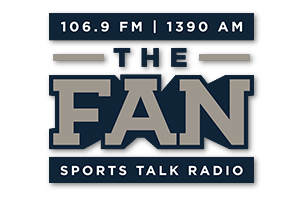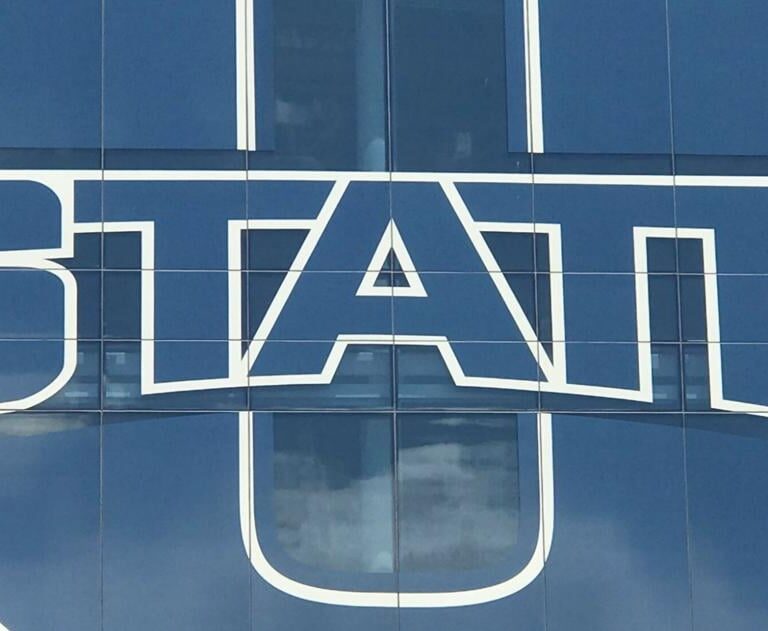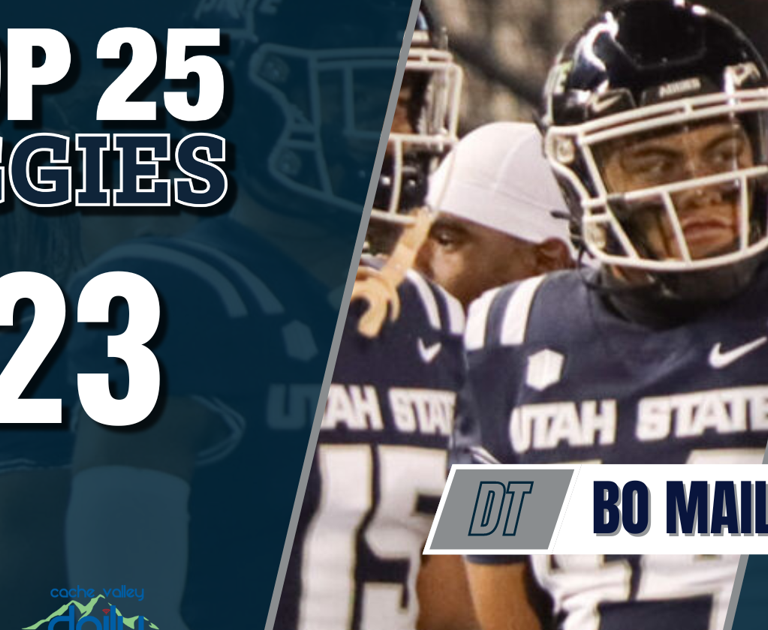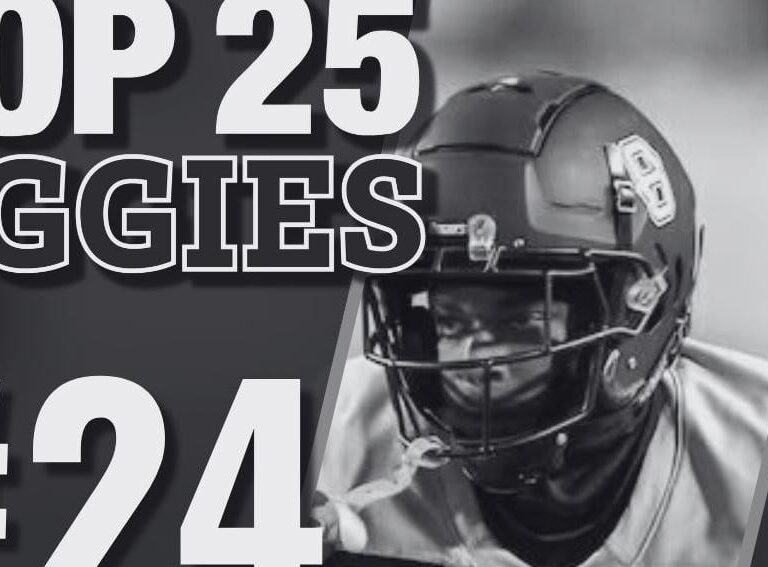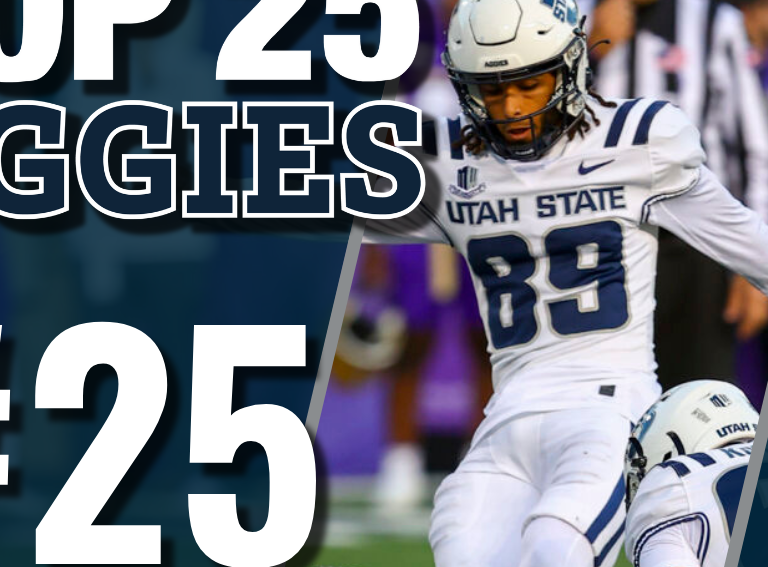Utah State wide receiver Micah Davis (4) is tackled by Iowa linebacker Jay Higgins (34) during the first half of an NCAA college football game, Saturday, Sept. 2, 2023, in Iowa City, Iowa. (AP Photo/Charlie Neibergall)
In Blake Anderson’s opening statement to the media after Utah State lost 24-14 to No. 25 Iowa he made it pretty clear he wasn’t going to celebrate any “moral victories.”
“Keeping it close and beating the spread doesn’t fire me up a lot,” Anderson said.
And yet, there are contained several moral victories that can be noted. Anderson may not like moral victories, but in a season opener such as this he’ll certainly need them.
The main positive from this game is the fact that, despite numerous mistakes and issues, the Aggies stuck with it and truly gave themselves a chance to win in the fourth quarter. That effort came up short, but the fact it was there to begin with after going down 14-0 within a few minutes is something to be at least somewhat proud of.
“We proved that we’re not going to give up,” USU offensive lineman Wade Meacham said. “That we’re going to keep fighting until the clock hits zeros no matter what the situation is.”
The biggest turnaround for the team came on defense. On the first three drives of the game the Aggies gave up 159 yards, or 7.6 yards per play. After those first 10 minutes Utah State allowed 166 yards the rest of the way, a mere 3.4 yards per play. The run game especially saw a massive change. Iowa gained 42 of its 88 total rushing yards in a three-play span on the Hawkeyes’ second drive of the game. In other words, outside of three plays, USU allowed 44 yards rushing on 33 attempts.
A major aspect of Utah State’s stellar defensive play came from its consistent tackling, something the team distinctly lacked in 2022. Using tackle data from Pro Football Focus we can see just how effective tackling was in the game for the Aggies relative to previous seasons. In 2021 and 2022, Utah State averaged just over 11 missed tackles per game, reaching the double-digit missed tackle mark in 20 of 27 games. Against Iowa, PFF tagged USU with just five missed tackles, tied for second-fewest in the Anderson era (best is four in USU’s win over Air Force last year).
“Coach (Cauthen), he does a very good job making sure we put a lot of attention to detail into tackling,” USU safety Anthony Switzer said. “We do tackling circuit every day. That’s one of the main things he came in and said that we had to get better at.”
Switzer himself had a very good day in terms of tackling. He saved a touchdown early in the game by dodging two offensive linemen and then wrapping up Jaziun Patterson’s legs to get the solo takedown. He also had a tackle for loss on a huge 4th & 1 play with Iowa on USU’s 29-yard line. And later in the game he stonewalled a running back screen that threatened to convert a 3rd & long play.
Switzer wasn’t the only player to do well in the realm of tackling. The entire team did. Some players like MJ Tafisi, Simeon Harris and Switzer racked up tackles, but baked into those performances was the key improvement in that very few tackles were missed.
For all these positives, the negatives were clearly there and drove the Aggies to a loss. Most of those mistakes were self-created. Chief among them was penalties. And if there’s one of the negatives from this week’s loss that absolutely sets Anderson off it was the penalties. It’s an issue from last year that has carried over to this season already. Last year the Aggies averaged 8.5 penalties per game (129th of 131 FBS teams) for a loss of 77.5 yards on average (130th). Utah State pretty much nailed both those marks on Saturday with its 10 penalties for 75 yards. And on a scale of least-awful situations to be penalized to the absolute worst, the Aggies seemed to choose the worst possible times to get flagged. Here’s a quick rundown:
- Ralph Frias false start on 3rd & 4 on USU’s second drive (failed third down conversion on 3rd & 9)
- Poukesi Vakauta personal foul by jumping on a tackle pile late, saving Iowa from a 2nd & 12 on its own 46 (Iowa eventually kicked a FG on that drive)
- Ike Larsen personal foul on field goal, giving Iowa 1st & Goal (USU would still hold Iowa, though)
- Enoka Migao personal foul, hands to the face, that saved Iowa from 3rd & 8 (Iowa eventually scored touchdown on that drive)
- Back-to-back false starts that turned 3rd & 1 on the Iowa 15-yard line into 3rd & 11 (USU ended up turning it over on downs)
That’s six penalties in very, very unfortunate situations to be committing them. Take those away and the optimistic man could make a decent argument for an 11-point swing in favor of the Aggies on these penalties alone (reminder, Utah State lost by 10).
When asked about working on penalties, Anderson gave a nearly four-minute response where he outlined his philosophy on penalties and how to deal with them when they happen, a sentiment he shared last year when this issue kept cropping up. To summarize his lengthy response, Anderson breaks penalties down into a couple of categories which we’ll call “competitive” and “unforced errors.” The competitive penalties are your facemasks, hands-to-the-face, holding etc. You’re playing hard and you screw up.
“Those, you have to teach,” Anderson said of that kind of penalty. “You have to take the tape, and we will today as a staff in front of the entire team, and we’ll teach. Hand placement. If you feel a facemask, it’s got to move. If you feel a hand rise up into the face of an opponent, you have to move it. We’re going to try to teach, teach, teach those situations.”
The unforced penalties are the ones that absolutely grind Anderson’s gears. He expects the competitive penalties to happen because he teaches his players to “play with your hair on fire” and “getting up to the edge and not going across it.” Anderson twice pointed out in his response that this style has brought his teams multiple conference championships in his time at Arkansas State and Utah State. But the unforced unsportsmanlike penalties and late hits are not something he’s happy to deal with.
Anderson called out two specific penalties in this latter category: Vakauta’s jumping on the pile penalty and Josh Williams’ unsportsmanlike conduct penalty after a kick return in the fourth quarter. He noted that both players will be disciplined with respective punishments being tailored to each player’s role on the team.
“I hope that we can move past it,” Anderson said. “But also understand that if we’re going to play at the level of effort and intensity that we want, you’re going to have some times when we spill over that line. Hopefully, we can overcome those and avoid as many as possible.”
Among other things to overcome and improve upon is Utah State’s own passing game. Legas set a career-high in pass attempts (48) and completions (32) and still only threw for 213 yards. A big part of the low yardage does come from Iowa’s defense forcing Legas into shorter throws most of the time, but big plays were there at times. One of the most frustrating for the Aggies will be Legas’ interception in the second quarter.
“I really babied that ball and floated it in the air,” Legas said of the pass, “gave the safety time to go over. If I drive it then it’s probably a big play for us.”
Legas got baited by Iowa DB Xavier Nwankpa into throwing this pass too softly because Legas felt it was a wide-open window and didn’t want to risk an incompletion with a tougher throw. As a result it’s underthrown and Nwankpa has a somewhat difficult, but easily makeable play on the ball. If Legas lead Micah Davis further, driving the ball downfield, it would have been a much more difficult play for Nwankpa to break up and a well-placed ball is a touchdown. And that’s the extra frustrating aspect of this play. It was a touchdown play and pass, Legas just messed it up.
A similar problem plagued an earlier Legas throw that was also intercepted. It occurred on the final play of the second quarter but was called back for offside. Obviously, the Iowa player jumping offside led to Legas throwing the risky pass. There was no downside to the throw. It’s just that the pass was very poor. The odds of success would have been very low on a good pass, you just want to actually see that good pass.
There’s a lot Legas needs to do to improve and Anderson said as much in Monday’s press conference.
“Coop’s got to grow up this week. It’s my job to get him there,” Anderson said. “He’s got to grow up this week to help us to win games. He can be better than he was this week.”
One of the biggest hopes for the offense is that it should be able to diversify its attack a little better and be more capable of facing physical opponent down the line. Utah State were without its top two tight ends, Josh Sterzer and Broc Lane and that heavily impacted the Aggies’ play-calling. Will Monney was nominally the starter but had just one snap credited to him. Anderson said he simply didn’t feel comfortable throwing his two freshmen tight ends, Monney and recently converted QB Chase Tuatagaloa, into the thick of things against Iowa.
“You could tell even in pre-practice that both our young guys, Will and Chase, were extremely nervous,” Anderson said. “So we did what we thought was best, to give us a strategic opportunity to be successful.”
Anderson said the plan for the game initially was to utilize “11” personnel (one running back, one tight end, three wide receivers) for most of the game. Sterzer and Lane’s unavailability changed that and thus, in reality, the Aggies ran 14 plays with 11 personnel (out of 72). Roughly 86 percent of USU’s offense was run out of a four or five wide receiver set.
There was some hope that using these spread-out formations that Utah State could create something in the run game by facing a five-man defensive front, it just didn’t work out that way. The run game out of 10 personnel was pretty ineffective for the most part.
Late in the game the Aggies went nearly an entire drive using 11 personnel and it resulted in several of the best runs of the day. Wyatt Bowles (#91 in the following clips despite being #60 on the roster) played tight end on these snaps, as he did for pretty much all 11 personnel plays.
The Aggies ran the ball six times out of 11 personnel and got 44 yards out of it. From 10 personnel they got 82 yards on 17 attempts (adjusting for one sack that gets included in official run totals). That’s 7.3 yards per carry from 11 and 4.8 from 10.
Despite the differences in those numbers it’s too soon to just say “run more 11 personnel once the tight ends get healthy.” Anderson said fatigue on Iowa’s part may have played a part in that turnaround. After all, that drive came in the fourth quarter. It also came in a situation where Iowa may not have been expecting runs (since the Aggies were trailing by three scores with under seven minutes to play in the game). Still, it’s good to see that work and the option to at least have it will make USU’s offense better moving forward.
As a final note, the Aggies simply need to get a little luckier. A bad bounce here and a bad bounce there can turn a game. For the Aggies there were four or five plays where luck favored the Hawkeyes when otherwise Utah State might have had four or five huge, momentum-swinging plays. It’s hard to blame the Aggies in any of these scenarios as they actually created many of these chances themselves, though Anderson did place some blame on his team for failing to capitalize on those opportunities.
This first of the biggest turnover chances wasn’t really too bad. MJ Tafisi jarred the ball loose (with additional help from Blaine Spires) from Kaleb Johnson’s arm on an up-the-gut run and recovering those fumbles is often a coin flip. Ike Larsen and Iowa’s Gennings Dunker were seemingly the first to spot the loose ball but Dunker was right next to it while Larsen was a few yards away and recovering it came down to that difference in distance.
At 8:48 in the second quarter, the Aggies had just forced their first three-and-out of the game, which alone could have worked as a momentum swing, but ball-hawk Ike Larsen got it into his mind that he wanted a fourth career blocked punt and got his hand on the kick of All-American punter Tory Taylor. But apparently being an All-American means that even your blocked punts are good because after deflecting off Larsen’s hand and landing 12 yards past the line of scrimmage it rolled an additional 26 yards. In other words, Larsen blocked a punt and it still went 38 yards.
Perhaps the Aggies used up all of their luck because on a similarly blocked punt last year, that went about the same distance on the fly, Jaden Smith was in the perfect spot to catch it and return the kick 56 yards for a touchdown.
Larsen had two other plays where he got his hand on a pass but couldn’t reel in an interception. The first was on a goal-line stand where Iowa wound up scoring on a 4th down attempt and later in the third Larsen came even closer to an interception. On replay it looks like he got most of the way through what would have been a catch-of-the-year interception but just couldn’t haul it in.
The worst of all the near-turnover plays, though was Iowa’s muffed punt that the Aggies didn’t seem to realize was a muffed punt. The ball clipped the helmet of one of the Iowa blockers and fell right in front of Paul Fitzgerald who didn’t seem to realize the prize literally at his fingertips. The Hawkeyes pounced on the ball quickly and so the Aggies’ chance at getting a free possession starting at the Iowa 32 went poof.
Something that could sort of fit in this bad luck category is Iowa’s first touchdown. Seth Anderson got free from Michael Anyanwu for a 36-yard touchdown reception. Anyanwu fell down, probably due to tripping on Anderson’s feet. Were it not for that, Anyanwu would have at least had a decent chance to swat the ball away or make the pass more difficult (Switzer said Anyanwu was “in great position until he fell”). Anderson still would have had a strong chance to catch the touchdown anyway, but you’d rather have the option where your veteran corner is at least in the play.
